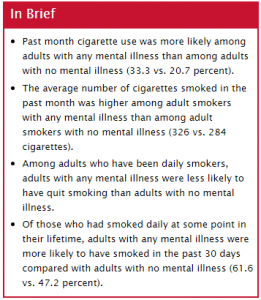Tobacco use continues to be the leading cause of preventable death in the United States.1,2Despite further evidence provided in the 2010 Surgeon General’s Report that cigarette smoking causes disease and that no level of cigarette use is safe,2 rates of cigarette use among certain groups of Americans remain high. Cigarette use among people with mental illness has garnered attention and concern over the past decade.3 For example, previous research has shown that people with mental illness are not only more likely to smoke, but they also smoke more frequently than people with no mental illness.4,5 For example, people with mental illness or a substance use disorder account for 25 percent of the adult population, but they consumed 40 percent of cigarettes sold in the United States.6 People who are receiving treatment for a mental illness also have lower cessation rates of smoking than those people who are not seeking mental health treatment.7 This report uses data from the 2012 to 2014 National Surveys on Drug Use and Health (NSDUHs) to provide up-to-date information on the relationship between smoking and mental illness.8
NSDUH is the primary source for statistical information on illicit drug use, alcohol use, substance use disorders, and mental health issues for the U.S. civilian, noninstitutionalized population aged 12 or older. One of NSDUH’s strengths is the stability in the sample and survey design that allows multiple years of data to be combined to examine the behavioral health of specific subgroups, such as smoking among people with mental illness. NSDUH asks people aged 18 or older if they ever smoked part or all of a cigarette. Respondents who had smoked are asked if they smoked in the past 30 days, the average number of cigarettes they smoked on days they smoked in the past 30 days, and if they ever had smoked daily. NSDUH also has an indicator of having had any mental illness (AMI) in the past year. AMI among adults aged 18 or older is defined as having had a diagnosable mental, behavioral, or emotional disorder (excluding developmental and substance use disorders) of sufficient duration to meet diagnostic criteria specified in the fourth edition of the Diagnostic and Statistical Manual of Mental Disorders during the year before the survey interview.9 Estimates of AMI are based on predictive models.10 An estimated 18.1 percent of adults had AMI in 2014.11
This issue of The CBHSQ Report compares past month cigarette use among adults with past year AMI and among adults with no past year AMI. In this report, adults with no past year AMI are referred to as having no mental illness. The report also includes a comparison of the prevalence of smoking cessation among adults with past year AMI with those with no past year mental illness. The estimates are based on a total combined sample size of about 142,100 adults aged 18 or older, including 28,400 adults with past year AMI. All findings presented in this report are annual averages based on combined 2012 to 2014 NSDUH data. All differences discussed in this report are statistically significant at the .05 level.

